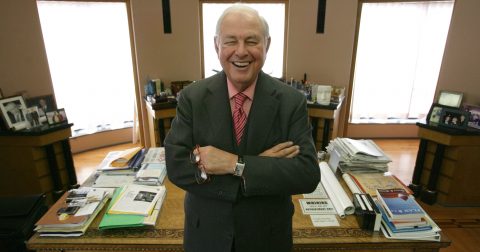58 out 77 lots of Taubman’s collection were bought at Sotheby’s: but all the top pieces came from art dealers
- Adolph Alfred Taubman, January 31, 1924 – April 17, 2015.
- Frank Stella, Delaware Crossing (1961), sold at Sotheby’s last Wednesday for $13.690.000.
The first of the four auctions of former Sotheby’s owner Alfred Taubman’s art collection ended less the 48 hours ago, but despite the effort the oldest auction house in the world put into it, optimists will likely remember this crucial sale as an incomplete victory, while sceptics will look at it as a partial defeat if considering the high risk taken by assuring the seller for half a billion dollars.
The numbers say that 8 on 77 main lots fail to find a buyer, and the auction’s tally was $377,034,000, including buyer’s commission charged by the auction house. The Taubman Collection was valued at $375 million to $527 million before the sale, without buyer’s commission. Tad Smith, Sotheby’s president and chief executive, took the microphone before the auction announcing that Sotheby’s had saved Mr. Taubman a seat for the evening and that was probably what Taubman would have done for himself if he were still alive. He had a feeling for good manners. As Christopher Mason reported in his book dedicated to the price fixing scandal Taubman was convicted of in the early 2000s, the businessman who invented shopping malls in US made a clear point about good matters since the first meeting with Sotheby’s London staff, in October 1983:
“Never in his life, he told them, had he been treated so haughtily as he had during his experiences as a client of Sotheby’s – thought he acknowledged that Christies’s came pretty darn close in terms of superciliousness and general rudeness. Alienating the customers was no way to run a business, he warned, and such conduct would no longer be acceptable.” (The Art of the Steal: Inside the Sotheby’s-Christie’s Auction House Scandal, 2004).
But despite that empty chair, people at Sotheby’s don’t seem to have learned the lesson very well. During the last contemporary and post-war sale in London a good client of the firm who has an evident leg’s disease was rudely refused of a chair to attend the auction because the chairs, said the attendant, were all already taken. Bad marketing could have been the hidden mistake committed by the company also in the case of their former president’s art collection.
The evident mistake was being too positive about the market. Alex Rotter, the head of Sotheby’s New York Contemporary Art department, was right stating after the auction that “it’s a credit to Mr. Taubman that 90 percent of the works he bought over the last 60 years found buyers over two hours in one evening. Would I have wished we made a billion dollars? – he added – Sure. But with 90 percent sold, it’s hard to be disappointed.” Yes, but as a matter of fact too many lots went under the low estimate; the market is not happy when this happens and buyers lose confidence, especially when huge capitals are involved. An ambitious and expert hedge fund manager such as Mr. Daniel Loeb, who struggled last years to take control of the company, is well aware of it.
Nevertheless, there are at least two reasons to be optimists following the results of this seminal auction. The first is that once again the market has proved to be able to swallow highly expensive pieces by artists such as Amedeo Modigliani and Mark Rothko. That shouldn’t be taken for granted if one considered the amount of modern and contemporary art which went under the hammer in London less than a month ago. It might also prove that the art market is still expanding.
The second reason, which nobody seems to have underlined up to now, is that 58 out of 77 lots were sold to Mr. Taubam by Sotheby’s itself, between 1978 (Miró, New York, May 1978) and 2013 (Moholy-Nagy, London, June 2013). Therefore it’s quite easy to spot some of the gains he made on certain works such as, for instance, Schiele’s drawings and watercolours. The one which belonged to Sir Sean Connery, for instance, was acquired under the low estimate in 2008 by Taubman for $1.160.000 (7 May, Soth. New York). It went for $ 1.150.000, basically keeping its value. But the watercolour he bought in 1999, 1 May, for $375.000, in this case above the estimate, sold for $3.370.000; and another one he bought the day after, 12 May, for $270.000, under the estimate, sold for $1.690.000. Similarly the watercolour he bought close to the high estimate in 1996 for $420.000 sold for $2.110.000. Would this be enough for any art investor to be happy? If not, just have a look at the Picasso’s once in the collection of Gianni Versace that Taubman acquired in 1999, 7 Dec, for $4.810.000, almost a million under the low estimate. It sold last night for $20.000.000. Yes, indeed 5 million under the low estimate.
At this point a last fact ought to noticed, and it should made auctioneers re-consider the tricky system of giving insurance to clients who want to sell their pieces with no risks, and that most of the times ends up penalizing the pieces with no insurance, for it become less dangerous for the auction house if they go unsold: most of the top lots, that is to say those by Stella, Modigliani, De Kooning, Kline and Rothko just to name a few, were actually acquired by Mr. Taubman from private galleries. In this silver group of 16 masterpieces only one went unsold, and they made $144.519.000, that is to say almost the 50% of the tally.
August 26, 2019


